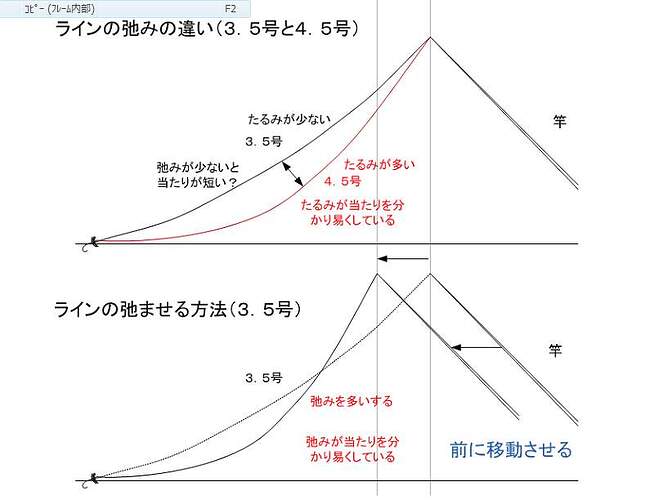I finally found again an old blog post from 2009 I was looking for a month ago to post here.
レベルライン3.5号! Level Line No. 3.5
Not long after starting tenkara I found this webpage, and I used to try to figure out what his diagram was trying to tell me. With only the vaguest guess. I’ve gotten better at translating Japanese so I understand it better now.
https://plaza.rakuten.co.jp/tenten2843/diary/200912010000/
Basically he is making the transition to using lighter lines. And trying to figure out the advantages and disadvantages. And figure out what adjustments he will need to make to use the lighter line.
Writing there are two schools or factions: The tapered line group: where ease of casting the line is priority, and the weight of the line is just accepted. Then the other group, the level line faction, where minimum otsuri is the priority.
But, his dilemma is he believes the most important thing in tenkara is to have line slack, to be able to take more Atari. ( he writes this in red in his blog post)
Writing this is not just his opinion alone.
That two tenkara heavy weights, Sebata-san and Katayama-san both also say so, and they are the best, are they not?
He begins from the pov of thinking a heavier line is a good thing. Because it will provide enough line slack to take more atari. The diagram is his thinking out loud, how to prove or disprove that idea or understand the adjustments to be made when switching to using a lighter line.
Here is the diagram from the above blog post.
3.5号と4.5号のラインの自重差による現象と対策
Phenomenon and measures due to the weight difference between the line of No. 3.5 and No. 4.5
Top diagram:
ライン弛みの違い (3。5号 と 4。5号)Difference in line slack ( or sag if you prefer)
(3。5号 )
たるみが少ない=「弛るみが少ない」There is little slack.
(3 ways of writing the same thing, I think. Sometimes a different font translates better.)
弛みが少ないと当たりが短い? If the slack is small, the hit/atari is short?
たるみが少ないとアタリが短い? When the slack is small, the Atari is short?
弛みが少ないとヒットが短い? Slack is small, the hit is short?
(short as in brief or quick)
4。5号
たるみが多い。There is a lot of sag/slack.
たるみが当たりを・分かり易くしている Sagging makes hits · easy to understand
たるみがアタリを・分かり易くしている Slack is easy to understand - the Atari
弛るみがアタリを・分かり易くしている Slack makes Atari · easy to understand
· easy to understand ( I think, easy to sense or grasp, the atari / hit)
Bottom diagram:
ラインの弛ませる方法 (3。5号 )To slacken the line method (No. 3.5)
弛みを多いする。Make a lot of slack. (increase the line slack/sag)
前に移動させる move forward. [ the rod position]
The idea is that with 3.5 line, the rod must be moved forward to increase line sag, (or as explained in the text, lower the rod top to increase line sag)
「ライン」弛みが当たりを分かり易くしている
“Line” slack makes it easier to understand hits
「ライン」弛みがアタリを分かり易くしている
“Line” slack makes Atari easier to understand (sense)
(In the top diagram, this is a question. Here it is asserted that increasing line sag makes it easier to take atari. And should be done.)
ラインの弛みがない ⇒ There is no slack in the line ⇒
アタリがとれず → Atari can not be taken →
フッキング率が大幅に減少 Hooking ratio is greatly reduced
[Well, so much for tight lines advice, or I guess if you take this view, when someone tells you, “tight lines”, they’re putting a spell on you, so you wont catch many fish] ![]()
その対策として、竿を前に出す、または竿先を下げて、意図的にラインの弛みを作るように心掛ける必要があります。
こうすることによって、なんとかアタリがとれることがわかりました。
As a countermeasure, it is necessary to intentionally make the line slack by putting the rod forward or lowering the stick tip.
By doing this it turned out that Atari could be taken.
Of course none of this is new. I just finally got to the point where, I believe anyway, that I could understand his explanation.
He writes that this season he is doing less sight fishing. Longer lines I assume. And using his previous No. 4.5 line had to much line otsuri.
ラインを軽くした目的は、毛鉤を流している最中に、
ラインの自重により、毛鉤が引かれる(オツリ)
現象の防止したいためです。
The purpose of lightening the line is that while drifting the kebari,
Due to the weight of the line, a fly/kebari is drawn (Otsuri)
I want to prevent this phenomenon.
But moving to No. 3.5 line, he wondered if he would miss atari due to reduction in the amount of line sag. To avoid that - from the bottom diagram, he reasoned, the solution is to move the rod fast enough to keep the needed line sag, or lower the tip of the rod to keep proper line sag.
Anyway, my purpose of posting this is not to teach anything new, I could have just kept it to my self for my own amusement. The purpose for posting was just to show how other people also go walking down the path to trying to understand line behavior by drawing out diagrams. At least once in awhile. You might notice his posting date, Dec 1st. Off season. Can’t fish, might as well ponder such things. ![]()
Please, look at his blog post for the rest, the above should help the odd digital translations. If such things interest you. (maybe I got lucky and got most of it right, but better to read the original source)

